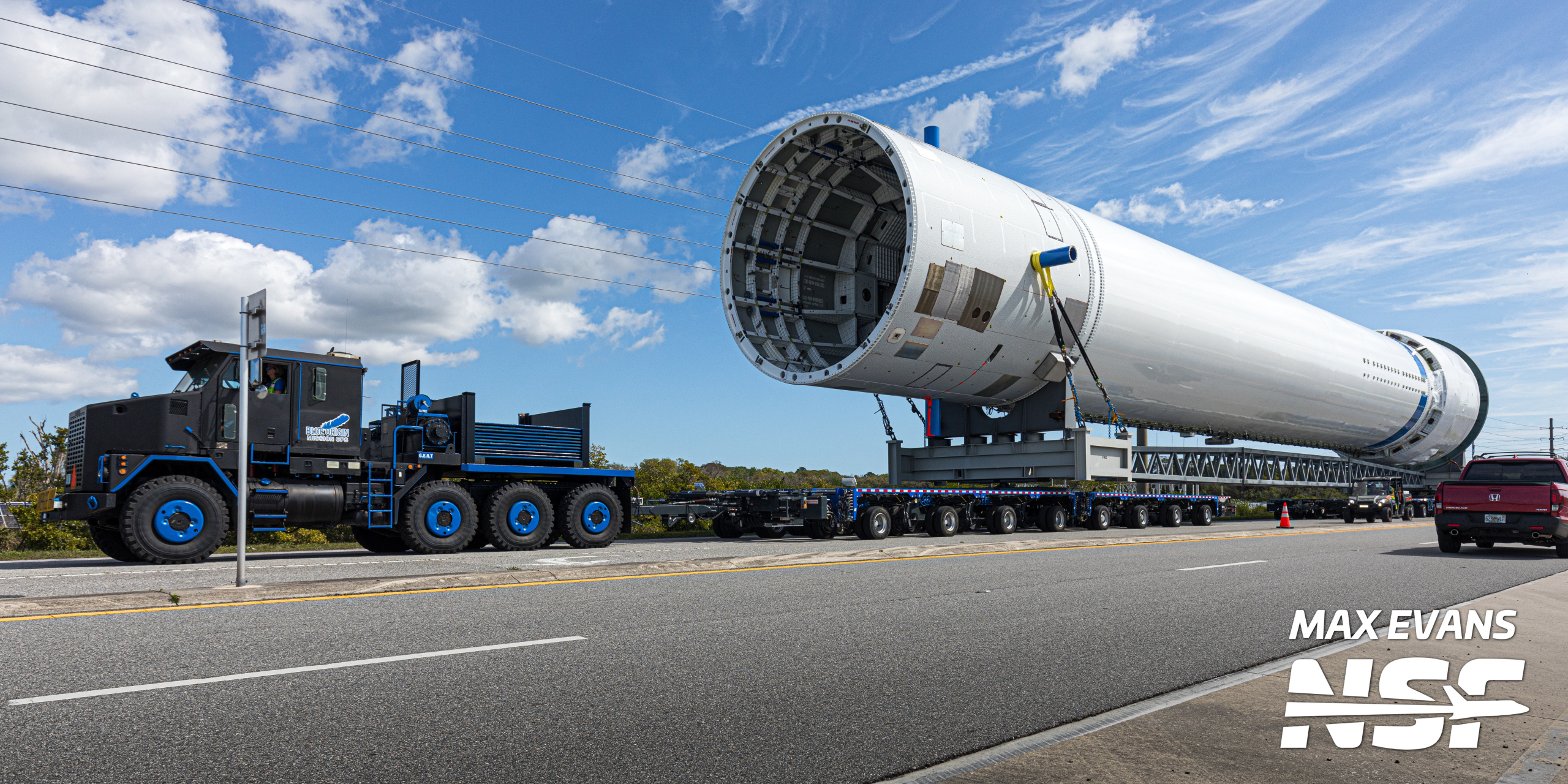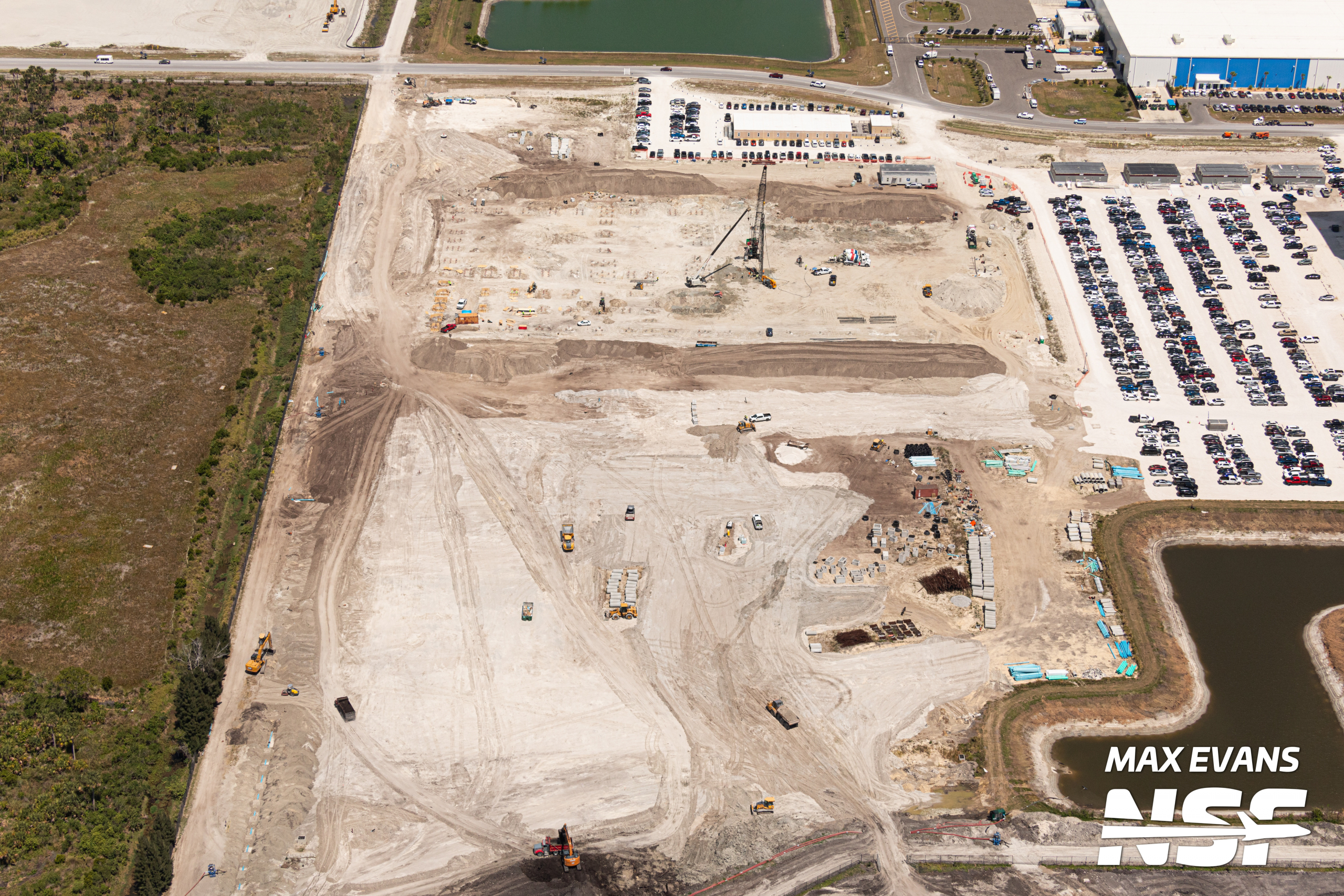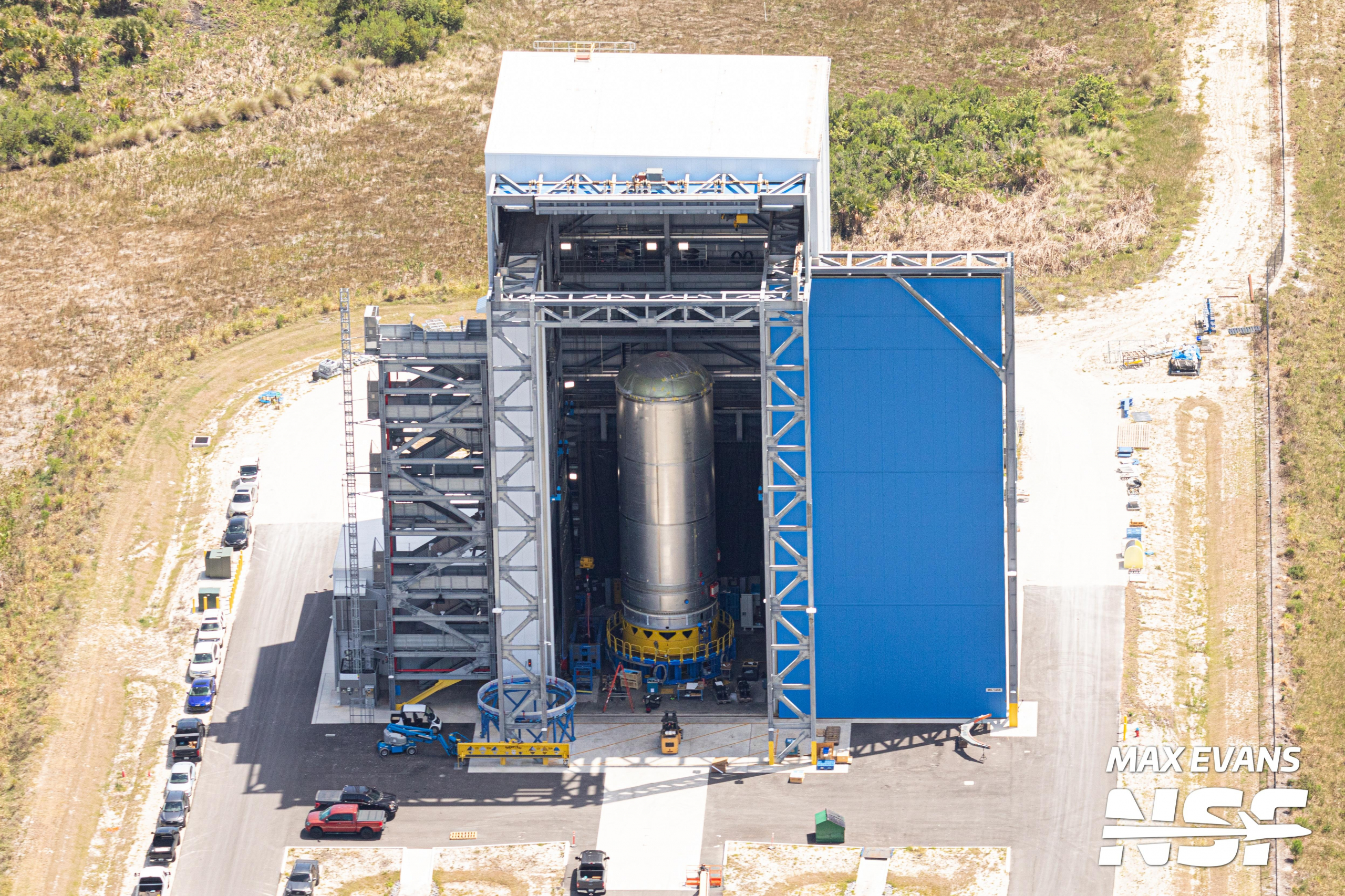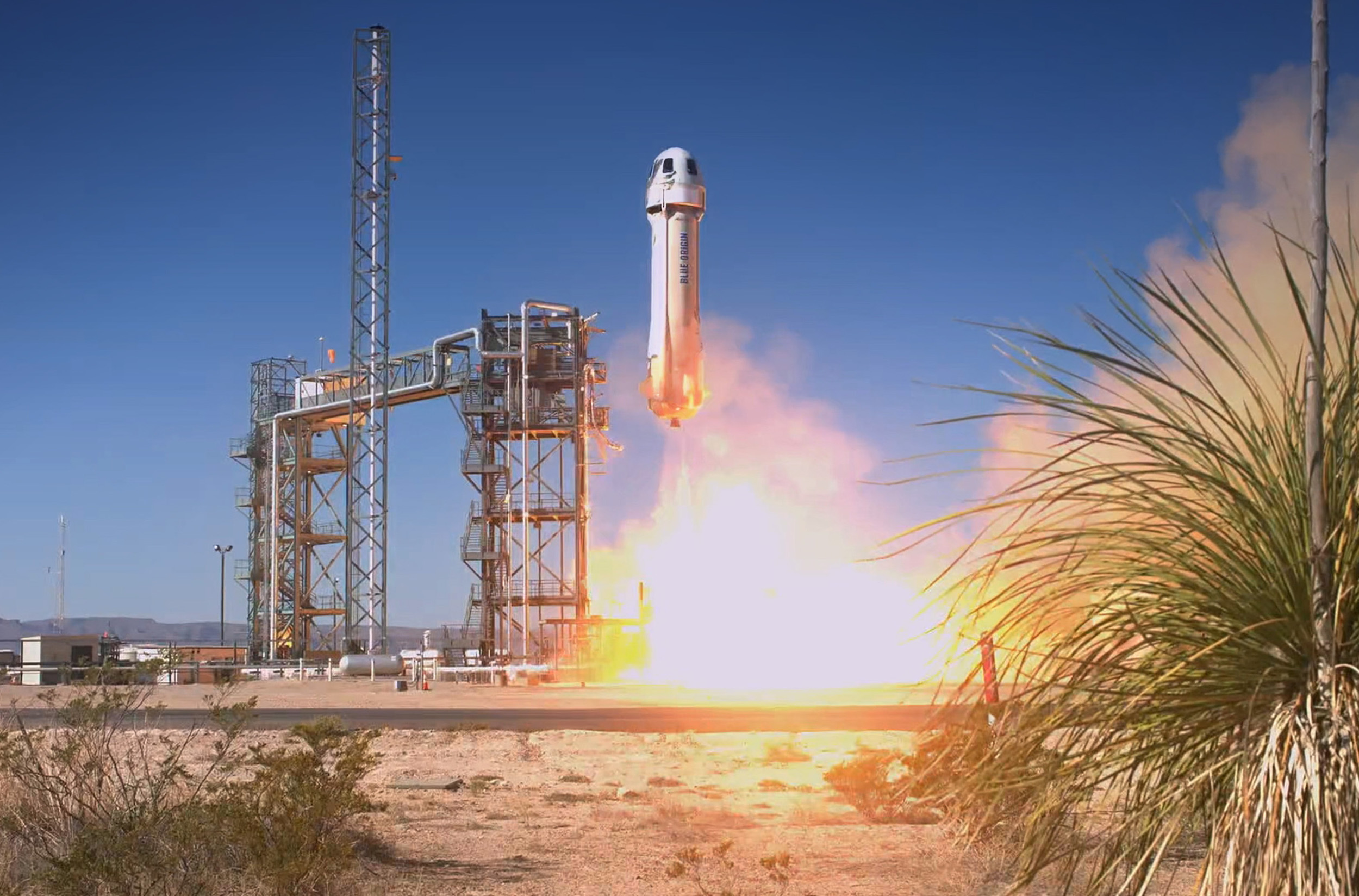Over the past few months, Blue Origin has been busy moving forward with several of its projects as target dates draw closer. New Glenn continues to move closer to launch, facilities are expanded, BE-4 engines have been delivered to ULA, and New Shepard has returned to crewed flights.
New Glenn
As the September launch window for NASA’s EscaPADE Mars mission approaches, teams are working on completing testing at Launch Complex 36 (LC-36) to prepare the site for its first static fire and launch .
On March 12, Blue canceled the New Glenn Pathfinder first stage after completing cryogenic and ground system tests on the launch pad. The 25-foot-wide, 150-foot-long stage made its way back to the company’s campus at Exploration Park, just outside the gates of the Kennedy Space Center.

The first stage of New Glenn’s Pathfinder is returned to the factory after cryogenic testing. (Credit: Max Evans for NSF)
Back inside the stage one integration facility, it’s likely that the stage will be closely inspected after its round of testing. From there, the stage will be integrated with an engine section and BE-4 engines that could support static fire alongside a flight-ready intermediate stage and possible aerodynamic surfaces. It’s still unclear if this booster will fly with the same hardware it does static firing with, or if there will be further upgrades before the vehicle is ready to fly.
In late March, Blue Origin brought the second stage transporter-erector to the launch pad for additional testing and checks. A New Glenn second stage has not yet been transported on this structure, although Blue may still have planned this test before New Glenn’s first flight. The second stage transporter-erector has two cutouts at its base, suggesting the possibility of testing the two BE-3U engines on the launch pad.
Most recently, on May 23, the new Glenn simulator moved to the main transporter-erector platform to allow for further testing on the platform. According to Blue Origin, the tests will involve turning on pumps to pressurize the vehicle’s hydraulic system, using ground systems to feed the rocket with raw materials, as well as a rapid retraction test of the umbilical connections. Such tests are an important part of the countdown to the launch of a new rocket and launch pad infrastructure.
NEWS: Blue Origin’s New Glenn landing craft is called Landing Platform Vessel 1.
The ship was captured while passing through Istanbul while leaving its construction shipyard in Romania. The barge is currently being fitted out in France.
Full photo credit and thanks to Daniil:… pic.twitter.com/xJWhf5JdCZ
– Gav Cornwell (@SpaceOffshore) May 30, 2024
A long-awaited update on the New Glenn offshore landing platform arrived recently as Landing Platform Vessel 1 was transferred from Romania to France. The modified barge is still under construction as large quantities of scaffolding remain on board. According to the documentation, the ship measures 116 x 46 m. It’s not yet clear when it will be transported to Port Canaveral – but when it does, it will bring New Glenn closer to launch.
All of these developments bring New Glenn and its infrastructure closer to the inaugural launch, still scheduled for the end of this year.
Exploration Park
At Blue’s Space Coast rocket production campus, work continues to support not only New Glenn production and operations, but also the company’s other programs, such as Blue Moon.

Preparatory work for the Lunar Assembly Facility is well underway on the Blue Origin campus. (Credit: Max Evans for NSF)
Recent documents from Space Florida reveal that Blue is currently working on building a Lunar Assembly Facility (also known as the Project Lunar Production Facility). It replaces the proposed Composite Assembly Building which was revealed in public planning documents in 2022. Preparatory works for this approximately 18,000 square meter building are currently underway, although the expected completion date is unknown.
Blue Origin still aims to launch the first Blue Moon MK1 cargo lunar lander to New Glenn in early 2025 as an exploratory mission to test the system’s technologies. After the MK1 cargo lander, Blue is contracted by NASA to land cargo and crew on the Moon as part of the Artemis program with its MK2 lander. With that in mind, it makes sense that Blue would want to make sure there’s enough space to produce its landers right on the Space Coast.
To support all of this, Blue is also building a new parking lot to accommodate the growing number of employees and contractors on site, along with older plans showing the company intends to construct more buildings on a large existing parking lot. area on the south side of campus.

A second floor New Glenn inside the 2CAT building. (Credit: Max Evans for NSF)
During a flyover last month, a New Glenn second-stage tank was captured standing vertically inside the 2CAT building on Blue’s property. This is where the stages are believed to be pressure tested before moving on to the next stages of production. Nearby, what appeared to be a shrouded section of a New Glenn first floor lay outside on cradles.
BE-4 tests and deliveries
In recent months, residents of the Huntsville area — where NASA’s Marshall Spaceflight Center is located — have reported an increase in rocket engine testing from the area. NASA and Blue Origin signed a Commercial Space Launch Act agreement in 2019 under which the company would refurbish the historic 4670 test stand for use with its BE-3U and BE-4 engines. The increased testing is a good sign not only for New Glenn, which requires seven BE-4s per first stage and two BE-3Us per second stage, but also for ULA’s Vulcan rocket which uses two BE-4 engines per rocket.
I see a pair of BE4 engines about to go on their booster for USSF106, #VulcanRocket This is the first national security mission. #CrowdedFactory pic.twitter.com/aU3fRciEEO
– Tory Bruno (@torybruno) May 29, 2024
In addition to these reports, ULA CEO Tory Bruno recently shared an image showing two BE-4 engines and a Vulcan first stage, both of which will carry out the rocket’s third mission. Bruno recently said that the delivery rate of BE-4 engines for Vulcan was two per month and increasing to one and a half engines per week.
New Shepard
After an in-flight anomaly caused by New Shepard’s BE-3 engine nozzle in September 2022 and a successful return to flight with an uncrewed mission in December 2023, New Shepard resumed flight with passengers on board on May 19. New Shepard up to 107 km and back for a total mission time of just under 10 minutes.

New Shepard takes off during mission NS-25. (Credit: Origine Bleue)
Although the flight was completed safely, it was observed that only two of the three main parachutes were deployed on the capsule. Although the craft is designed to land safely on only two main drops, there is no doubt that Blue will look into this issue before the next mission.
(Main image: Deploying the new Glenn simulator on the LC-36 for additional testing of ground systems. Credit: Blue Origin)